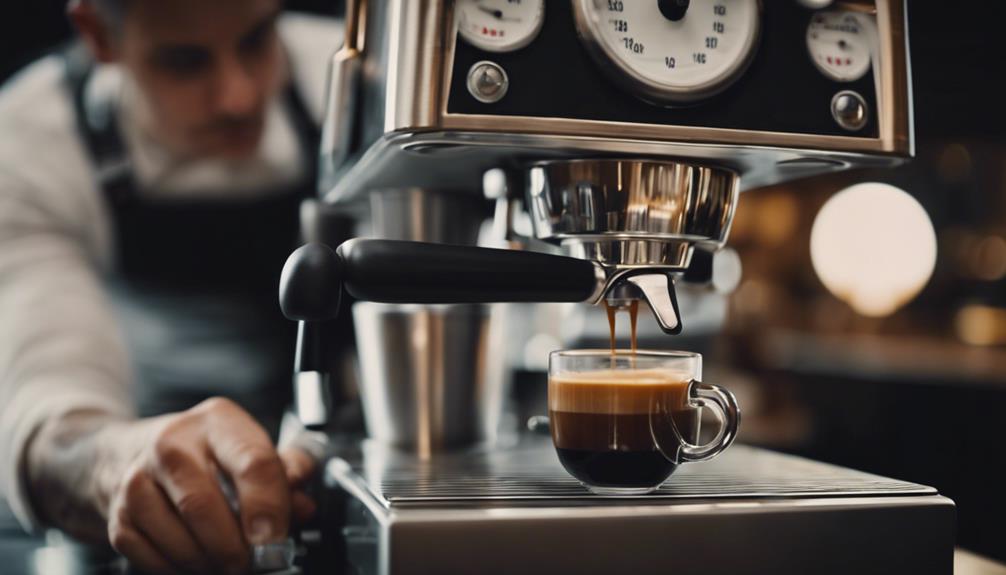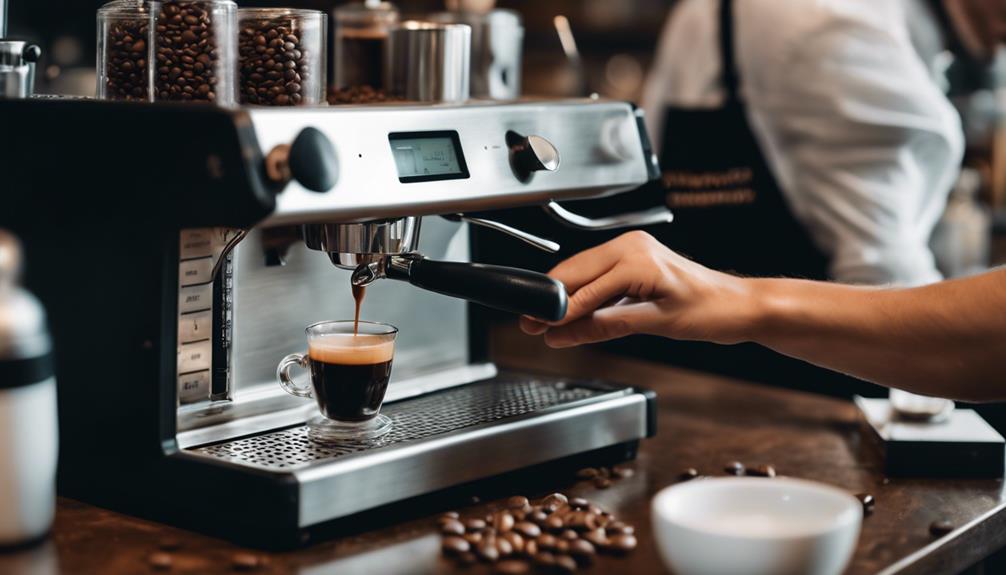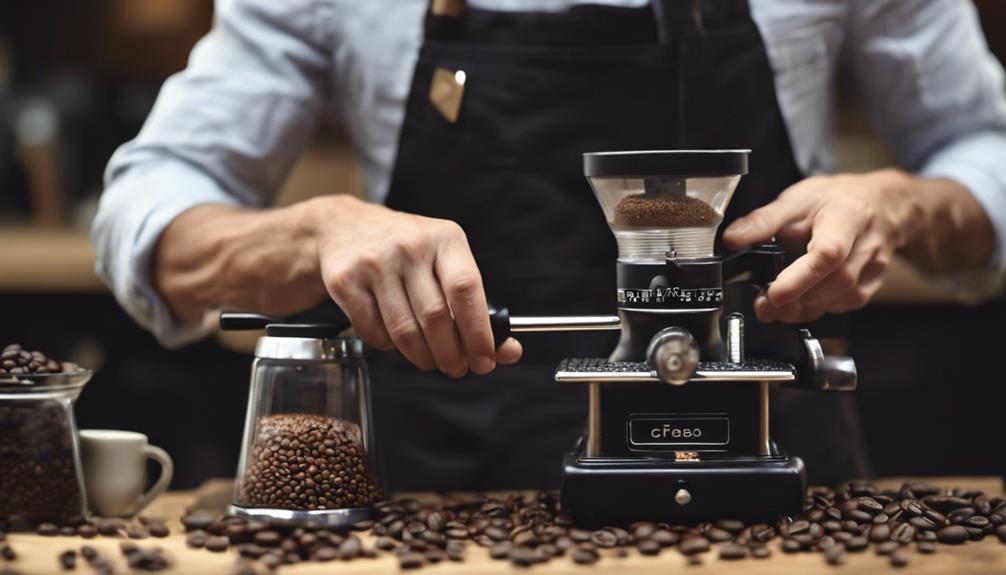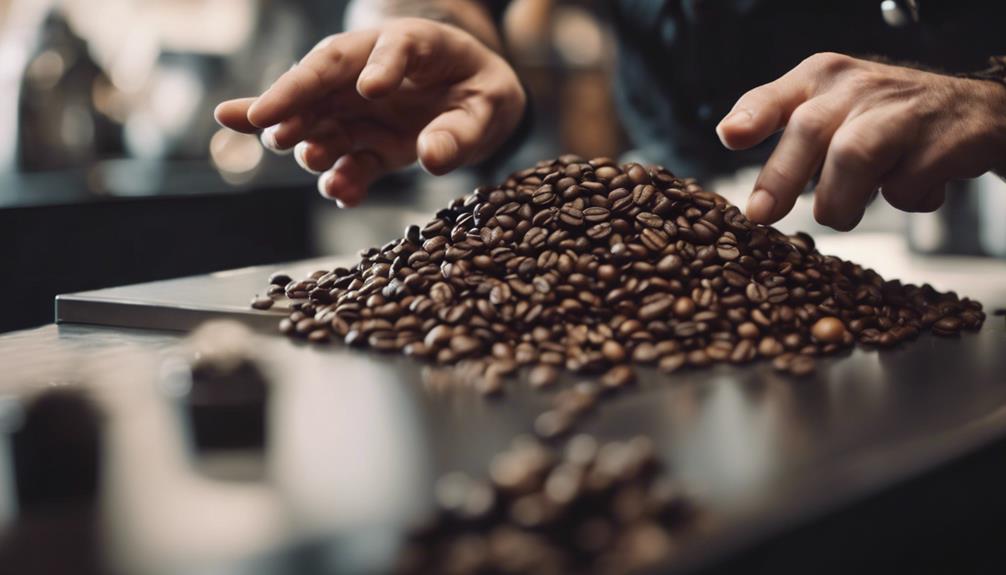To enjoy a less acidic espresso, consider using beans from regions such as Brazil or Sumatra that have been naturally processed. Opt for medium or medium-dark roasts for a more mild acidity. You can experiment with longer extraction times or adjust ratios to achieve a smoother taste. A good espresso should balance acidity to enhance sweetness and bitterness. Understanding the type of beans, roast level, and extraction methods can help you fine-tune the acidity levels. Compare dark and light roasts to experience bold versus fruity notes. Keep in mind that acidity levels vary; dark roasts tend to be smoother while light roasts are brighter. The process of extracting espresso is crucial for achieving a balanced flavor. Factors like roast levels and brewing time can influence the acidity. Low acid espresso is considered to be easy on the stomach. You can experience smooth flavors by exploring different brewing techniques.
Key Takeaways
- Lower acid espresso beans sourced from regions like Brazil and Sumatra offer a milder acidity profile.
- Roasting to a medium or medium-dark level reduces acidity in espresso.
- Experiment with longer extraction times and adjusting coffee-to-water ratios to lower acidity.
- Quality espresso balances acidity with sweetness and bitterness for a nuanced taste.
- Understanding bean variety, roast level, and extraction methods fine-tunes espresso acidity levels.
Lower Acid Espresso Beans
Lower acid espresso beans sourced from regions like Brazil, Sumatra, and parts of Central America offer a milder acidity profile favored by many espresso enthusiasts.
These beans, known for their less acidity, are often processed using natural or honey methods to enhance sweetness and reduce the sharp tang commonly associated with higher acid coffee beans.
By choosing these beans, you can enjoy a smoother espresso experience without the overpowering acidity that some find off-putting. Roasting these beans to a medium or medium-dark level can further minimize acidity while bringing out their unique flavor characteristics.
Many coffee lovers appreciate the balanced and gentle taste that lower acid espresso beans provide, making them a popular choice among those seeking a more nuanced coffee experience.
Blending these beans with others can also create a well-rounded espresso with a subtle acidity that appeals to a broader range of palates, offering a versatile option for coffee enthusiasts looking to explore different flavor profiles.
The Impact of Roast Level

Understanding how the roast level influences the acidity of espresso beans is vital for selecting the perfect brew to suit your taste preferences. The roast level plays an essential role in determining the acidity levels in your espresso.
Here are some key points to keep in mind:
- Dark roast espresso beans are known for their lower acidity levels, resulting from prolonged roasting that brings out bolder flavors.
- Lighter roast espresso beans retain more of their natural acidity, offering a brighter and fruitier flavor profile that appeals to many.
- Medium roast espresso beans strike a balance between boldness and acidity, making them a versatile choice for those who enjoy a harmonious combination of flavors.
- Acidity in espresso tends to be mellowed in dark roasts, allowing other flavor notes to take the spotlight.
- Lighter roasts showcase the inherent fruity and acidic notes of the beans, providing a more pronounced and vibrant taste experience.
Brewing Techniques for Reduced Acidity

To achieve a smoother and less acidic espresso, consider experimenting with various brewing techniques to tailor your coffee to your taste preferences.
Longer extraction times can reduce acidity in espresso by extracting more flavor compounds. Skipping the initial drops of espresso can minimize acidity since these drops are more intense and acidic.
Adjusting the coffee-to-water ratio allows for a balanced shot with reduced acidity. Additionally, tweaking the grind size and coffee dose can customize the taste of espresso to lower acidity levels.
If you allow your espresso to cool slightly before tasting, the dissipating crema can lead to a milder acidity experience. By incorporating these brewing techniques, you can enjoy an espresso that's less acidic and suits your palate preferences.
Experimenting with these methods will help you find the perfect balance of flavors in your espresso, enhancing your coffee-drinking experience.
Quality Vs. Acidity in Espresso

When it comes to espresso, quality doesn't just hinge on acidity but also on the overall balance of flavors, body, and aroma.
A great espresso can still shine with lower acidity as long as the flavors work together harmoniously.
The key is for acidity to enhance the taste profile rather than dominate it, allowing for a nuanced and enjoyable coffee experience.
Acidity in Espresso
Acidity in espresso plays a crucial role in defining the overall taste experience, balancing between quality and acidity to create a harmonious flavor profile.
When exploring acidity in espresso, consider the following:
- The bright and tangy notes of acidity can elevate the complexity of your espresso.
- Quality espresso finds a delicate equilibrium between acidity, sweetness, and bitterness for a well-rounded flavor profile.
- Factors such as bean origin, roast level, and brewing parameters all influence the acidity levels in your espresso.
- High-quality espresso often showcases acidity as a desirable trait that enhances the overall taste experience.
Understanding and appreciating the role of acidity in espresso can lead to a more nuanced and enjoyable coffee tasting journey.
Taste Vs. Acidity
In evaluating espresso, consider how the balance between taste and acidity contributes to the overall quality of your coffee experience.
While acidity can enhance the complexity of espresso, it's vital to achieve harmony with other flavor components. Quality espresso exhibits acidity without overwhelming sourness, creating a well-rounded taste profile.
When brewing espresso, factors like roast level, bean selection, and brewing techniques play an important role in balancing acidity to deliver a pleasant drinking experience. Remember that coffee can vary in acidity levels, and finding the right balance is key to enjoying a satisfying cup.
By skillfully managing acidity in espresso, you can highlight its quality while ensuring a harmonious flavor profile that delights your taste buds.
Understanding Espresso Acidity Levels

Factors such as bean variety, roast level, and extraction method all play a role in influencing the acidity levels of espresso. Darker roasts, for example, usually exhibit lower acidity due to the extended roasting period that breaks down the naturally occurring acids. Understanding the chemistry behind espresso extraction is important in managing and modifying acidity levels to suit your preferences.
Here are some key points to explore when examining espresso acidity levels:
- Experimenting with different bean varieties can reveal varying acidity profiles, offering a spectrum of flavors to enjoy.
- Roast levels impact acidity, with darker roasts generally yielding a smoother, less acidic brew.
- Adjusting extraction methods, such as pressure and brew time, can fine-tune the acidity to your liking.
- Comparing espresso acidity with other brewing methods can highlight the unique tang and depth espresso brings to the palate.
- Delving into the science of espresso extraction can enhance your control over acidity levels, leading to a more personalized coffee experience.
Dark Roast Vs. Light Roast

When choosing between dark roast and light roast espresso beans, consider the impact on roast intensity, flavor profile differences, and acidity levels.
Dark roast beans offer a richer, smokier taste, while light roast beans provide a brighter, more acidic profile with fruity and floral notes.
Your preference for flavor intensity and acidity will guide your decision between dark and light roast espresso beans.
Roast Intensity Impact
Roast intensity plays a pivotal role in determining the acidity level of your espresso, with dark roast and light roast beans showcasing distinct flavor profiles. Dark roast espresso beans are known for being less acidic compared to their light roast counterparts. The prolonged roasting process of dark roast beans results in a bold and rich flavor profile, which tends to tone down the acidity levels in the espresso.
On the other hand, light roast espresso beans retain more natural coffee acids, offering brighter and fruitier notes that contribute to a higher acidity level in the brew. Understanding the impact of roast intensity on the overall acidity of your espresso is essential in crafting your desired flavor experience.
- Experimenting with different roast intensities can lead to discovering your preferred acidity level.
- Dark roast enthusiasts may enjoy the deep, smoky flavors with milder acidity.
- Light roast aficionados might appreciate the vibrant acidity and complex fruity undertones.
- Roast intensity can influence the balance between acidity and bitterness in your espresso.
- Choosing between dark and light roast beans allows for customization of your espresso's flavor profile.
Flavor Profile Differences
The contrast between dark roast and light roast espresso beans lies in their distinct flavor profiles. Dark roast espresso beans offer a bold, smoky taste with lower acidity levels. On the other hand, light roast espresso beans maintain a higher acidity, resulting in a brighter, fruitier flavor profile. These differences are primarily influenced by the roasting styles applied to the beans. Modern trends in the world of espresso lean towards lighter roasts due to their enhanced acidity and complex flavor notes. Understanding the roast level of espresso beans is essential in predicting the acidity levels they will exhibit in the final cup.
| Espresso Beans | Roasting Styles | Flavor Profile |
|---|---|---|
| Dark Roast | Bold, smoky | Reduced acidity levels |
| Light Roast | Bright, fruity | Higher acidity levels |
Acidity Levels Comparison
Comparing dark roast and light roast espresso reveals a significant distinction in their acidity levels. Dark roast espresso typically has lower acidity levels compared to light roast espresso. This difference arises from the roasting process: dark roasts are exposed to higher temperatures for a longer duration, which reduces the acidic compounds in the beans.
On the other hand, light roast espresso retains more natural acids, resulting in a higher acidic profile. The acidity in espresso is greatly influenced by the roast level, with darker roasts offering a smoother, less acidic taste. Understanding these differences in acidity levels between dark and light roast espresso can assist you in selecting the preferred flavor profile.
- Dark roast: Smooth and less acidic.
- Light roast: Bright and higher acidity.
- Acidity reduction in dark roasts.
- Natural acids retained in light roasts.
- Roast level impacts the acidity profile.
Espresso Extraction Process

During the espresso extraction process, hot water passes through finely ground coffee under high pressure, resulting in the rapid extraction of flavors.
The grind size of the coffee beans plays a vital role in this process. If the grind size is too fine, the water may struggle to pass through, leading to over-extraction and a bitter taste. Conversely, if the grind size is too coarse, the water may pass through too quickly, resulting in under-extraction and a sour taste.
Achieving the right grind size is essential for a well-balanced espresso shot.
The high pressure in espresso machines aids in efficiently extracting flavors from the coffee grounds. Understanding the interaction between grind size and extraction time is key to controlling the acidity, body, and overall flavor profile of the espresso.
Factors Affecting Espresso Acidity

When it comes to the acidity of your espresso, factors like bean roast levels and brewing time play a significant role.
The blend and roast level of your coffee beans will greatly impact the acidity profile of your espresso shots.
Understanding how these elements interact can help you fine-tune your brewing process for the perfect balance of flavors in your cup.
Bean Roast Levels
Roast levels greatly impact the acidity of espresso beans. Darker roasts typically result in lower acidity due to caramelization of sugars during the roasting process. Lighter roast levels, on the other hand, tend to have higher acidity as they retain more of the natural acids from the coffee cherries.
If you prefer a balanced flavor profile, medium roast levels might be the way to go, offering a harmony between acidity and sweetness in your espresso. It's important to recognize that the roast level greatly influences the taste of your espresso, with dark roasts delivering a bold and more traditional flavor.
By understanding the connection between roast level and acidity, you can choose espresso beans that align with your taste preferences.
- Experiment with different roast levels to discover your preferred acidity level.
- Consider how the roast level impacts the overall flavor profile of your espresso.
- Explore the nuances of acidity in espresso to deepen your appreciation for different roast levels.
Don't be afraid to step out of your comfort zone and try new roast levels to expand your palate. Keep in mind that personal taste plays an important role in determining the ideal roast level for your espresso.
Brewing Time Factors
To influence the acidity of your espresso, consider adjusting the brewing time factors. The duration of extraction plays an important role in the final taste profile of your coffee. Longer brewing times can result in a more balanced flavor extraction, potentially reducing the acidity in your espresso. Additionally, a simple technique like discarding the initial few drops of espresso can help mitigate the acidic taste in your shot.
Experimenting with different brewing times and ratios of coffee to water during extraction can greatly impact the acidity levels of your espresso. By fine-tuning these variables, you can tailor the flavor profile to your preference, whether you enjoy a brighter, more acidic taste or prefer a smoother, milder cup.
After brewing, allowing your espresso to cool slightly before tasting can also help mellow out any sharp acidity present in the brew. By being mindful of brewing time factors, you can effectively control and adjust the acidity levels in your espresso to achieve a more balanced and enjoyable flavor profile.
Health Benefits of Low Acid Espresso

Low acid espresso offers a digestive-friendly option that may benefit individuals with sensitive stomachs or acid reflux. Here are some health benefits of choosing low acid espresso:
- Reduced acidity can help alleviate symptoms of acid reflux, making it a more comfortable choice for those with this condition.
- Lower acid levels in espresso lead to a smoother taste, providing a more enjoyable drinking experience without the harsh bitterness.
- Opting for low acid espresso can decrease the likelihood of stomach irritation, promoting better digestive health overall.
- Some people find that low acid espresso is easier on their digestion, leading to a feeling of improved well-being after consumption.
- By choosing low acid espresso, you can enjoy a milder flavor profile while still indulging in the richness of a good cup of coffee.
Exploring Smooth Espresso Flavors

Exploring the world of smooth espresso flavors opens up a domain of delightful taste experiences that can be achieved through various brewing techniques and ingredient choices.
Lower acid espresso, known for its milder and smoother taste, offers a balanced flavor profile with reduced acidity levels. Opting for lighter roast styles in espresso beans can contribute to this lower acidity, enhancing the overall smoothness of the brew. Additionally, longer extraction times during brewing can help in creating a smoother, less acidic espresso shot that's pleasing to the palate.
To further enhance the smoothness of your low-acid espresso, consider experimenting with different ratios of coffee to water and varying grind sizes. These adjustments can play a significant role in achieving a velvety texture and a more refined flavor profile.
Cooling the espresso slightly before tasting can also aid in mellowing out any remaining acidity, resulting in a truly smooth and enjoyable espresso experience.
Frequently Asked Questions
How to Pull Less Acidic Espresso?
To pull less acidic espresso, adjust brewing parameters. Try increasing brew temperature or altering coffee-to-water ratios.
Cooling down the shot slightly before tasting can also reduce acidity. Experiment with grind size and dose for a smoother taste.
Professional baristas recommend fine-tuning these factors to achieve a desired low-acid espresso. By making these adjustments, you can create a more balanced and enjoyable coffee experience with less acidity.
How to Tell if Coffee Is Low in Acid?
To determine if coffee is low in acid, consider the origin of the beans. Those from Brazil or Sumatra often yield lower acidity. Look for descriptors like 'smooth,' 'mellow,' or 'balanced,' indicating reduced tartness.
Low-acid coffee typically has a pH closer to neutral (around 7) and may offer a sweeter taste. Specialty coffee shops often feature specific low-acid espresso options on their menu, providing a clue to its acidity level.
Does Low Acid Coffee Really Make a Difference?
Low acid coffee can indeed make a significant difference for those with sensitive stomachs. By opting for lower acid espresso, you can enjoy a smoother taste that's gentler on digestion.
The process of removing acidic compounds creates a milder flavor profile without sacrificing quality. For individuals prone to acid reflux, choosing low acid coffee can lead to a more pleasant drinking experience while potentially offering health benefits.
What to Do if Espresso Is Too Sour?
If your espresso tastes too sour, there are several methods you can try to balance the acidity in your shot and improve its taste. Adjusting the extraction time, trying different bean blends, fine-tuning grind size and dose, using a longer pre-infusion, and experimenting with brew temperature can all make a difference. Don't hesitate to explore these adjustments to find the perfect balance for a more enjoyable espresso experience.
These methods can help you refine your brewing process and enhance the flavor profile of your espresso.
How Does Lower Acid Espresso Provide Benefits Compared to Regular Espresso?
Lower acid espresso offers significant benefits of espresso for those with sensitive stomachs. By reducing the acidity, it is gentler on the digestive system and may prevent discomfort or heartburn. Additionally, lower acid espresso allows for a smoother flavor profile, without sacrificing the boldness and richness that espresso is known for.
How Does Lower Acid Espresso Compare to Under Extracted Espresso?
Lower acid espresso offers a smoother taste with reduced acidity, making it a great option for those with sensitive stomachs. On the other hand, under extracted espresso causes a sour and unpleasant flavor due to the inadequate extraction of coffee solubles. It’s important to find the right balance for a perfect cup.
Conclusion
To sum up, when it comes to enjoying a smooth and low acid espresso, it's all about selecting the right beans, roast level, and brewing techniques.
Remember the old saying, 'You are what you drink,' and choose quality over acidity for a truly satisfying espresso experience.
By understanding the factors that impact acidity levels and the health benefits of low acid espresso, you can savor every sip of your favorite coffee drink with confidence and enjoyment.









